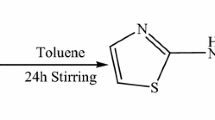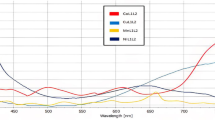Abstract
A template condensation of 2,6-dihydroxybenzaldehyde with nicotinic hydrazide at 20 °C yielded a tridendate ligand with the formation of azomethine bond. The structure of the ligand, H3L2 was confirmed with the use of analytical and spectroscopic analysis such as CHN analysis, ESI mass spectrum, FTIR, UV–visible spectrum and NMR techniques. The use of 2D NMR further confirmed the structure of the ligand. Also, five ligand–metal complexes were synthesized using different techniques. The physico-chemical properties of the complexes were determined with the use of melting point determination, conductivity test, micro-analysis, metal content determination (AAS), magnetic susceptibility measurements, FTIR, UV–visible spectra, ESR, TG/DTG and p-Xray diffraction study. The structures of the metal complexes were elucidated based on the analytical and spectroscopic data obtained. However, the anti-tubercular activities of the compounds were evaluated against H37Rv strain of Mycobacterium tuberculosis, in vitro. The results obtained indicated that the metal complexes are more active than isoniazid with MIC = 0.91 µg/mL. V(II) complex was found to be the most active with MIC of 0.62 µg/mL while Cu(II) complex with MIC values of 0.85 µg/mL is the least potent among the metal complexes synthesized. However, the results of the cytotoxicity against vero cells indicated that the metal complexes are more toxic when compared to the standard drug.














Similar content being viewed by others
References
M.C.D.S. Lourenço, M.D.L. Ferreira, M.V.N. De Souza, M.A. Peralta, T.R.A. Vasconcelos, M.D.O. Henriques, Eur. J. Med. Chem. 43, 1344 (2008)
T. Aboul-Fadl, F.A.S. Bin-Jubair, O. Aboul-Wafa, Eur. J. of Med. Chem. 45, 4578 (2010)
M. Shahar Yar, M.A. Ali, M.M. Abdullah, Med. Chem. Res., 16, 292 (2007)
M.V.N. De Souza, Drug Discovery 1, 33 (2006)
Y.L. Janin, Bioorg. Med. Chem. 15, 2479 (2007)
T. Scior, S.J. Garces-Eisele, Curr. Med. Chem. 13, 2205 (2006)
B.N. Swamy, T.K. Suma, G.V. Rao, G.C. Reddy, Eur. J. Med. Chem. 42, 420 (2007)
L.G. Dover, G.D. Coxon, J. Med. Chem. 54, 6157 (2011)
R. Rappuoli, A.A. Aderem, Nature 473, 463 (2011)
World Health Organization, Tuberculosis-fact sheet, (104,1-3, Geneva 2000)
L. Jia, J.E. Tomaszewski, C. Hanrahan, L. Coward, P. Noker, G. Gorman, B. Nikonenko, M. Protopopova, British J. Pharmacol. 144, 80 (2005)
A. Jindani, A.J. Nunn, D.A. Enarson, Lancet 364, 1244 (2004)
C.H. Anna, A. Rooda, J.W. Marijke, K. Klaas, V. Karen, G. Jerome, A. Koen, L. Holger, K. Anil, B. Dirk, Antimicrob. Agents Chemother. 53, 1290 (2009)
S.T. Cole, P.M. Alzari, Biochem. Soc. Trans. 35, 1321 (2007)
T. Aboul-Fadl, H.A. Abdel-Aziz, M.K. Abdel-Hamid, T. Elsaman, J. Thanassi, M.J. Pucci, Molecules 16, 7864 (2011)
J.K. Abeda, K. Anne, V. Duhme, S. Kiranmayi, S. Manjula, D. Prasad, P. Subhash, Dalton Trans. 41, 9192 (2012)
L. Ying-Hong, F. Hai-Gen, S. Feng, G. Li-Mei, T. Sheng, B. Chong-Wen, L. Yu-Huan, W. Yan-Xiang, S. Dan-Qing, Chem. Central J. 7, 117 (2013)
S. Ananthan, E.R. Faaleolea, R.C. Goldman, J.V. Hobrath, C.D. Kwong, B.E. Laughon, J.A. Maddry, A. Mehta, L. Rasmussen, R.C. Reynolds, J.A. Secrist III, N. Shindo, D.N. Showe, M.I. Sosa, W.J. Suling, E.L. White, Tuberculosis 89, 334 (2009)
S.T. Cole, P.M. Alzari, Biochem. Soc. Trans. 35, 1321 (2007)
J.H. Gross, Mass Spectrometry, 2nd edn. (Springer, Berlin, Heidelberg, 2011)
L.D. Field, S. Sternhell, J.R. Kalman, Organic Structures from Spectra (Wiley, Germany, 2008)
J.H. Simpson, Organic Structure Determination Using 2-D NMR Spectroscopy: A Problem-based Approach (Academic Press, USA, 2012)
H. Sie-Tiong, W. Yip-Foo, World Appl. Sci. J. 8, 1007 (2010)
P.B. Sreeja, A. Sreekantha, C.R. Nayara, M.R.P. Kurup, A. Usman, I.A. Razak, S. Chantrapromma, H.K. Fun, J. Mol. Struct. 645, 221 (2003)
F.X. Webster, R.M. Silverstein, Spectrometric Identification of Organic Compounds (Wiley, India, 2006)
M. Kuriakose, M.R.P. Kurup, E. Suresh, Spectrochim Acta. Mol. Biomol. Spectrosc. 66, 353 (2007)
Y.C. Ning, Structural Identification of Organic Compounds with Spectroscopic Techniques (Wiley, USA, 2005)
D.L. Pavia, G.M. Lampman, G.S. Kriz, J.A. Vyvyan, Introduction to Spectroscopy (Brooks Cole, USA, 2008)
A.D. Luiz, R.F. Thais, M.C. Chung, L.S. Jean, Int. Res. Pharm. Pharmacol. 2, 001 (2012)
A. Kriza, L.V. Ababei, N. Cioatera, I. Rău, N. Stănică, J. Serb. Chem. Soc. 75, 229 (2010)
S.A. Shama, H. Omara, Spectroscopy Letters. Int. J. Rapid Commun. 34, 49 (2001)
D. Sandhanamalar, S. Vedanayaki, R. Rajave, Int. J. Inorg. Bioinorg. Chem. 2, 5 (2011)
N.B. Patel, J.C. Patel, Arabian Journal of Chemistry 4, 403 (2011)
R.G. Chaudhary, H.D. Juneja, M.P. Gharpure, J. Therm. Anal. Calorim. (2012). doi:10.1007/s3-012-2616-8(2012)
R.M. Wood, D.M. Stucker, L.M. Jones, W.B. Lynch, K.M. Sushil, J.H. Freed, Inorg. Chem. 38, 5384 (1996)
M.Y. Hamed, J.B. Neilands, J. Inorg. Biochem. 53, 235 (1994)
A.A. Ahmed, H.K. Abdul Amir, M. Abu Bakar, Bioinorganic Chemistry and Applications, 2012, doi:10.1155/2012/795812 (2012)
Acknowledgments
The authors thank the technical staff of SAIF, Central Drug Research Institute, Lucknow, Indian Institute of Technology, Roorkee, and Indian Institute of Technology, Bombay, India, for analysis of our samples. This research work was financed by CISR and TWAS through fellowship.
Author information
Authors and Affiliations
Corresponding author
Rights and permissions
About this article
Cite this article
Ogunniran, K.O., Mesubi, M.A., Raju, K.V.S.N. et al. Structural and in vitro anti-tubercular activity study of (E)-N’-(2,6-dihydroxybenzylidene)nicotinohydrazide and some transition metal complexes. J IRAN CHEM SOC 12, 815–829 (2015). https://doi.org/10.1007/s13738-014-0544-1
Received:
Accepted:
Published:
Issue Date:
DOI: https://doi.org/10.1007/s13738-014-0544-1




